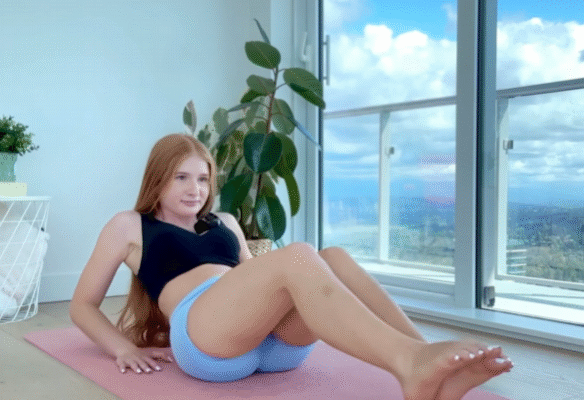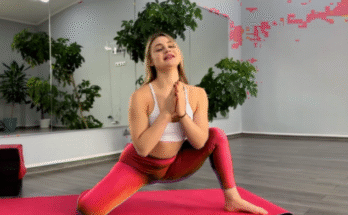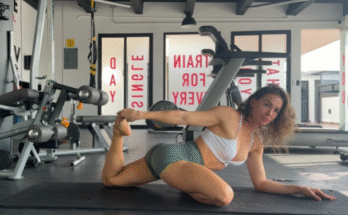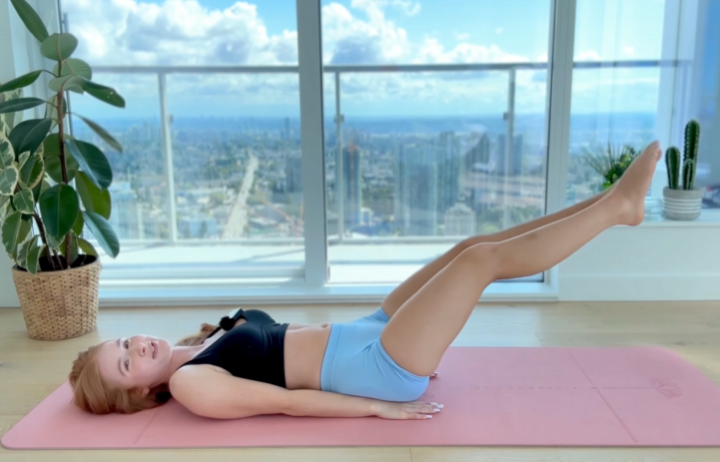
Early morning light slipped softly across the floor of Maya’s home studio, warming the polished wood beneath her bare feet. This was her favorite time of day—the quiet, the openness, the clarity before the world got noisy. As a movement coach who spent years helping people unlock stiffness and build confidence, she knew something many people often overlooked: before hip mobility comes core stability.
“Everything starts here,” she whispered, tapping the center of her abdomen. “A strong, awake core makes every stretch deeper, every hip opener safer, and every movement more powerful.”
And so today, she wanted to share what she often taught her students: three simple core exercises that dramatically improve stretching and hip mobility. They didn’t require equipment. They didn’t require an hour. They didn’t even require perfect form. All they needed was intention, breath, and consistency.
The studio was quiet. The morning was still. And Maya unrolled her mat, ready to demonstrate the flow she called her magic trio.
1. Dead Bug — The Foundation of Safe Hip Opening
Maya lowered herself gently onto her back, feeling her spine settle against the mat. She breathed in slowly, allowing her belly and ribs to expand. Then she lifted her legs into tabletop, knees stacked over hips, shins parallel to the floor.
“This,” she said softly, “is where core stability begins.”
She raised her arms straight upward, wrists over shoulders. From here, she extended her right leg and left arm forward, moving slowly, deliberately, maintaining a tight brace through her midsection. The key was control—no arching of the lower back, no wobbling, no rush.
Dead bug looked simple, but it was one of the most effective tools she knew.
“Why this exercise?” she often explained to clients. “Because it teaches your brain and body to stabilize the spine while your hips move independently.”
If the core couldn’t stabilize, the hips compensated. This meant tightness. Pinching. Limited range of motion. And sometimes even pain.
But with dead bug, something powerful happened:
The deep core switched on. The spine learned to stay neutral.
And the hips learned to move freely.
Maya repeated the motion slowly—left leg, right arm, then the opposite. Her movements were quiet, smooth, and deliciously controlled. Her breath guided the pace, a steady rhythm that made her mind quiet and her muscles awake.
“Just ten slow reps per side,” she whispered. “That’s all you need.”
She finished the set, drew her knees into her chest, and gave herself a gentle rocking massage before shifting to her next position.
2. Glute Bridge — Unlocking Hip Extension
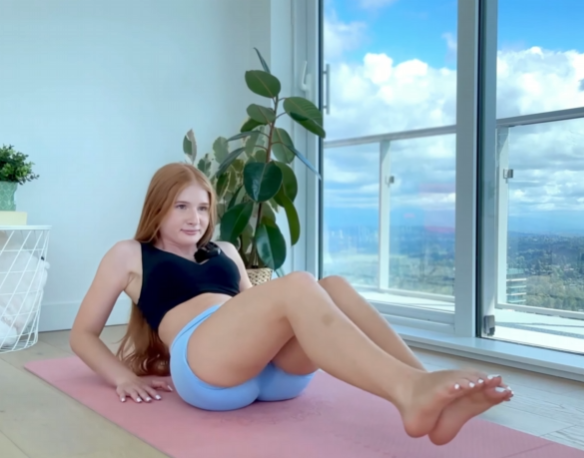
Rolling onto her back once again, Maya planted both feet flat on the floor, hip-width apart. She pressed her palms into the mat and took a deep inhale.
“Time to wake up the glutes,” she said.
With a slow exhale, she lifted her hips toward the ceiling, squeezing her glutes tightly at the top. The movement wasn’t about height. It was about control. Activation. Intent.
She held the bridge for a moment before lowering down gently, vertebra by vertebra.
Most people didn’t realize how much tight hip flexors were connected to weak glutes. If the glutes didn’t fire, the hips didn’t open. And if the hips didn’t open, stretching them felt like pushing against a locked door.
But when the glutes turned on?
Hip mobility improved immediately.
Hamstrings relaxed.
Lower back tension faded.
This wasn’t magic—just simple anatomy working correctly.
Maya switched to single-leg bridges, lifting her right leg toward the ceiling and pressing through her left heel. The motion challenged her stability, activating her glutes, hamstrings, and lower back support system.
She lowered and lifted, lowered and lifted.
“Strong glutes give your hips space to move,” she reminded herself. “They create the foundation for deeper stretches—pigeon pose, lunges, splits, everything.”
Her breath steadied. Her body grew warm. Her heart beat a little faster. She repeated the same number of reps on the other side, feeling each muscle fire with intention.
When she finished, she lay still for a moment, savoring the heat in her hips. The activation felt good—strong, empowering, alive.
3. Dead-Bug to Hollow Hold Transition — The Mobility Supercharger
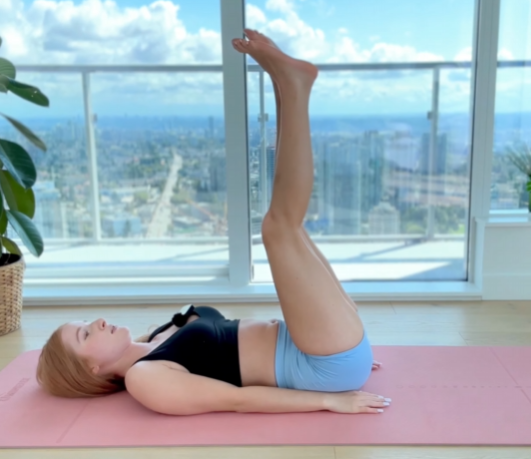
The final exercise was the most challenging, but also the most transformative.
Maya rolled to her back again and began in dead bug position—knees lifted, arms up, core engaged. She inhaled deeply. Then slowly, she extended both legs forward, lowering them toward the ground while pressing her lower back into the mat. Her arms reached overhead, and she floated her shoulders off the mat.
She had transitioned into a hollow hold.
“Now this,” she whispered with a smirk, “is the one that really changes everything.”
The hollow hold demanded true engagement from the deep core—the transverse abdominis, lower abdominals, and stabilizers that protected the spine. It forced the body to work in harmony, and it directly contributed to hip freedom.
If the core was weak, hip stretches felt shallow.
If the core braced properly, hip mobility flourished.
The hollow position wasn’t about perfection. Maya held it only as long as she could maintain proper form. The moment her lower back lifted or her legs dipped too low, she pulled back into dead bug—and then flowed right back into hollow again.
Dead bug to hollow.
Hollow to dead bug.
Back and forth, like a controlled wave of strength.
Her breath puffed in quiet exhalations. Her body trembled gently. The burn was delicious, intense, and awakening.
“This,” she breathed, “is the center of everything. Unlock the core, and the hips follow.”
After several cycles, she rested, sweat warming her skin.
Putting It All Together — A Core That Supports Mobility
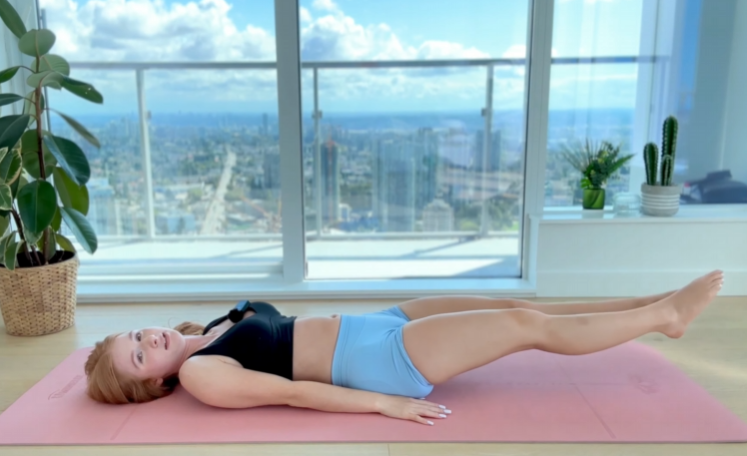
When Maya stood up, she moved through a deep lunge stretch.
Her hips opened more easily.
Her spine felt supported.
Her legs felt lighter, freer.
Then she shifted into a forward fold.
Her hamstrings lengthened without pulling.
Her lower back no longer guarded.
The difference was unmistakable.
A strong core didn’t just protect the body; it enhanced every movement—every hip opener, every hamstring stretch, every mobility drill.
And the best part?
These three exercises took less than ten minutes.
No gym.
No weights.
No complexity.
Just mindful movement.
Maya’s Final Words to Her Students
Before ending her session, she always reminded her students:
- Core stability improves hip flexibility.
- Hip mobility supports full-body movement.
- Consistency transforms your range of motion.
“Do these three exercises,” she said with a warm smile, “and your stretches won’t just feel deeper—they’ll feel effortless.”
As she rolled up her mat, the studio was brighter, warmer, alive with morning energy. She felt ready to start her day, knowing her body was supported from the inside out.
Strong core.
Open hips.
A body that moved with freedom.
The magic trio had worked once again.
